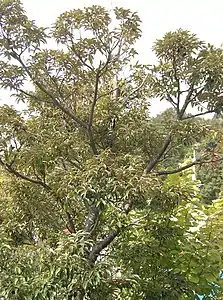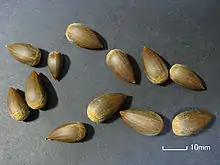| Castanopsis sieboldii | |
|---|---|
 | |
| Scientific classification | |
| Kingdom: | Plantae |
| Clade: | Tracheophytes |
| Clade: | Angiosperms |
| Clade: | Eudicots |
| Clade: | Rosids |
| Order: | Fagales |
| Family: | Fagaceae |
| Genus: | Castanopsis |
| Species: | C. sieboldii |
| Binomial name | |
| Castanopsis sieboldii (Makino) Hatus | |
| Synonyms | |
|
Castanopsis cuspidata var. sieboldii (Makino) Nakai | |
Castanopsis sieboldii, also known as the Itajii chinkapin or Itajii, is a species of evergreen tree that lives in subtropical eastern Asia.[1][2] This is a climax species that is commonly found in the Japanese temperate rainforest.[3] Specimens are also present within the forest area of the Tokyo Imperial Palace.
Castanopsis sieboldii was once thought to be a subspecies of the similar Castanopsis cuspidata.
Plants and animals associated with this tree include:
- Aspidistra elatior, the cast-iron plant, grows in the understorey.
- Acrocercops mantica, Chrysocercops castanopsidis, and Lymantria albescens[4] larvae of these Asian moths likely mine the leaves.
- Amantis nawai, a small praying mantis species native to Eastern Asia is known to live around C. sieboldii where it eats insects.
- Okinawa rail, a Japanese bird, lives among these trees.
Gallery
 Flower, female
Flower, female Nuts
Nuts Bark
Bark
References
Wikimedia Commons has media related to Castanopsis sieboldii.
- ↑ "Shii (Castanopsis sieboldii)". Thinking Like a Forest.
- ↑ "A Japanese useful tree: Castanopsis - Life in Kochi". Life in Kochi.
- ↑ "Canopy Multilayering and Woody Species Diversity of a Subtropical Evergreen Broadleaf Forest, Okinawa Island". hawaii.edu.
- ↑ "Moth Photographers Group – Lymantria albescens – 19458". msstate.edu.
This article is issued from Wikipedia. The text is licensed under Creative Commons - Attribution - Sharealike. Additional terms may apply for the media files.